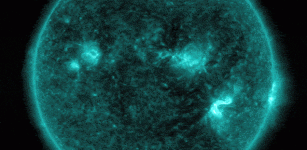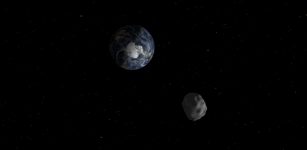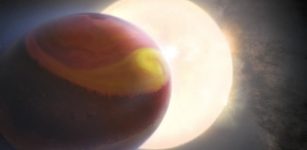Is Exo-Io Hidden Behind WASP-49b System An Extreme Version Of Jupiter’s Moon Io?
Eddie Gonzales Jr. – MessageToEagle.com – The most volcanically active body in our solar system is Jupiter’s moon Io, but there are also indications that an active moon outside our solar system, an exo-Io, could be hidden at the exoplanet system WASP-49b.
 Artist’s composition of a volcanic exo-Io undergoing extreme mass loss. The hidden exomoon is enshrouded in an irradiated gas cloud shining in bright orange-yellow, as would be seen with a sodium filter. Patches of sodium clouds are seen to trail the lunar orbit, possibly driven by the gas giant’s magnetosphere. Credit: University of Bern, Illustration: Thibaut Roger
Artist’s composition of a volcanic exo-Io undergoing extreme mass loss. The hidden exomoon is enshrouded in an irradiated gas cloud shining in bright orange-yellow, as would be seen with a sodium filter. Patches of sodium clouds are seen to trail the lunar orbit, possibly driven by the gas giant’s magnetosphere. Credit: University of Bern, Illustration: Thibaut Roger
“It would be a dangerous volcanic world with a molten surface of lava, a lunar version of close-in Super Earths like 55 Cancri-e,” Apurva Oza, postdoctoral fellow at the Physics Insitute of the University of Bern, said in a press release.
But the object that Oza and his colleagues describe in their work seems to be even more exotic than Star Wars science fiction: the possible exomoon would orbit a hot giant planet, which in turn would race once around its host star in less than three days — a scenario 550 light-years away in the inconspicuous constellation of Lepus, underneath the bright Orion constellation.
Astronomers have not yet discovered a rocky moon beyond our solar system and it’s on the basis of circumstantial evidence that the researchers in Bern conclude that the exo-Io exists: Sodium gas was detected at the WASP 49-b at an anomalously high-altitude.
“The neutral sodium gas is so far away from the planet that it is unlikely to be emitted solely by a planetary wind,” says Oza.
Observations of Jupiter and Io in our solar system show that an exo-Io could be a very plausible source of sodium at WASP 49-b.
“Sodium and potassium lines are quantum treasures to us astronomers because they are extremely bright,” says Oza, “the vintage street lamps that light up our streets with yellow haze, is akin to the gas we are now detecting in the spectra of a dozen exoplanets.”
For WASP 49-b the observed data can be best explained by the existence of an exo-Io. However, there are other options. For example, the exoplanet could be surrounded by a ring of ionized gas or non-thermal processes. “We need to find more clues,” Oza admits. The researchers are therefore relying on further observations with ground-based and space-based instruments.
“While the current wave of research is going towards habitability and biosignatures, our signature is a signature of destruction,” says the astrophysicist. A few of these worlds could be destroyed in a few billion years due to the extreme mass loss. “The exciting part is that we can monitor these destructive processes in real-time, like fireworks,” says Oza.
Written by Eddie Gonzales Jr. – MessageToEagle.com Staff










